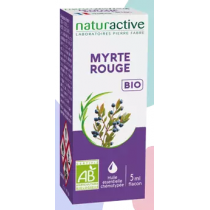Indications of Myrtle essential oil
Treats benign bronchial infections (anti-septic, mucous-flow, anti-spasmodic essential oil).
Botany information
Myrtus communis ct 1,8-cinéole Botanical family: Myrtaceae Producing organ: leaves Chemotype: 1.8 cineole, alpha-pinene, myrtenyl acetate Origin: Morocco
Botany specifications
This shrub, with a brown-red coloured bark covers the Mediterranean maquis with its little white flowers. A symbol of the Aphrodite goddess for the Greeks, the Myrtle is an important symbolic image in Arabic love poetry. The name remains attached to one of the most beautiful inner courtyards of the Alhambra palace in Granada in Andalusia.
Use
Diffusion +++, Bath +++, Massage +++, Orally ++
Ambient setting: on its own or in a mixture by regular low heat evaporation.
Atmospheric diffusion: in a mixture from a diffuser by spraying.
Dermal application: diluting, 5-15% (maximum 30%) in vegetable oil.
Orally: diluted with some vegetable oil - only after medical agreement. 1 drop 2 times per day.
Dry inhalation: 1-2 drops on a tissue.
Wet inhalation: 1-2 drops in bowl of boiling water.
Practical advice
Winter pathology : This oil is particularly useful for bronchial blockage and coughing. Dilute the Myrtle essential in macadamia vegetable oil and apply onto the thorax 2-3 times per day. It is also an atmospheric anti-septic when diffused during the winter months.
Breathe easier, Sleep easier : The Myrtle essential oil can be inhaled to clean respiratory tracts, calm coughing fits and relax the body before sleeping. For diffusion, you can combine it with the lemon essential oil: Put 10 drops of each into a spray diffuser, programmed for 5-10 minutes every 2 hours.
Contraindication
Contains eucalyptol. Not recommended for pregnant or breast feeding women or children under 8 years of age.




